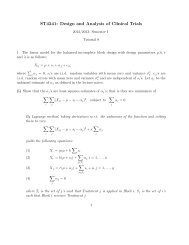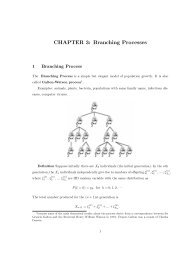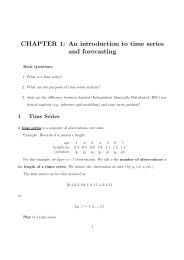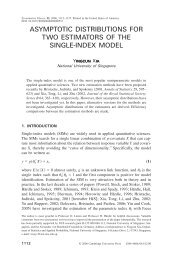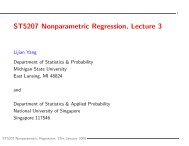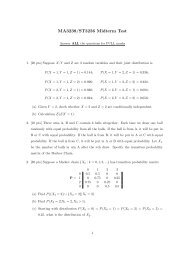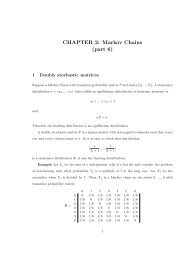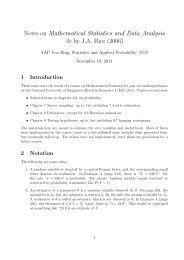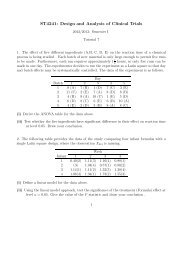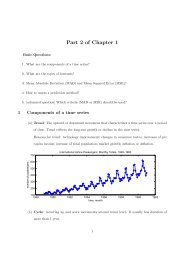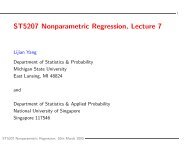honours project in mathematics - The Department of Statistics and ...
honours project in mathematics - The Department of Statistics and ...
honours project in mathematics - The Department of Statistics and ...
Create successful ePaper yourself
Turn your PDF publications into a flip-book with our unique Google optimized e-Paper software.
August 2009<br />
National University <strong>of</strong> S<strong>in</strong>gapore<br />
<strong>Department</strong> <strong>of</strong> <strong>Statistics</strong> <strong>and</strong> Applied Probability<br />
HONOURS PROJECT IN STATISTICS & APPLIED PROBABILITY<br />
GUIDELINES FOR STUDENTS<br />
To:<br />
All Students<br />
<strong>The</strong> Honours Programme <strong>in</strong> <strong>Statistics</strong> & Applied Probability<br />
Students <strong>in</strong> the Honours programme are required to read at least six lecture modules (level<br />
4000 <strong>and</strong> above) selected from the options <strong>of</strong>fered <strong>in</strong> their year <strong>of</strong> study. Each module will be<br />
the subject <strong>of</strong> a two-hour written exam<strong>in</strong>ation. In addition, each student must complete a<br />
<strong>project</strong> under the supervision <strong>of</strong> a staff member. This <strong>project</strong> constitutes 12 modular credits.<br />
Objectives <strong>of</strong> the Honours Project<br />
<strong>The</strong> Honours Project is <strong>in</strong>tended<br />
1. to give students the opportunity to work <strong>in</strong>dependently;<br />
2. to foster skills that will be <strong>of</strong> cont<strong>in</strong>u<strong>in</strong>g usefulness <strong>in</strong> their later career, such as<br />
* determ<strong>in</strong>ation <strong>of</strong> relevant sources;<br />
* statistical applications;<br />
* critical analysis <strong>of</strong> source material;<br />
* organization <strong>of</strong> relevant material;<br />
* presentation <strong>in</strong> written form;<br />
* presentation <strong>in</strong> spoken form.<br />
Implementation<br />
<strong>The</strong>re are five stages for a <strong>project</strong>.<br />
1. Progress Presentation<br />
One progress presentation is required <strong>in</strong> the first week <strong>of</strong> the follow<strong>in</strong>g semester. <strong>The</strong><br />
presentation takes 30 m<strong>in</strong>utes <strong>and</strong> 10 m<strong>in</strong>utes <strong>of</strong> questions <strong>and</strong> answers.<br />
<strong>The</strong> assessment will be based on the student’s underst<strong>and</strong><strong>in</strong>g <strong>of</strong> the exist<strong>in</strong>g literature<br />
relevant to the topic <strong>of</strong> the <strong>project</strong>; presentation skills <strong>and</strong> ability to answer questions.<br />
hon proj student guidel<strong>in</strong>es 1
August 2009<br />
2. First Submission<br />
This consists <strong>of</strong> a systematic study <strong>and</strong> elaboration <strong>of</strong> a topic chosen from an approved<br />
list, or, <strong>in</strong> exceptional circumstances, proposed by the student. An account <strong>of</strong> the<br />
knowledge ga<strong>in</strong>ed is given <strong>in</strong> a thesis. This work is done under the guidance <strong>of</strong> a<br />
Supervisor.<br />
<strong>The</strong> Honours thesis should be typed on A4 size paper (double-spac<strong>in</strong>g, s<strong>in</strong>gle-sided), with<br />
the st<strong>and</strong>ard format <strong>of</strong> the cover page (as shown <strong>in</strong> page 6). Two copies (each file <strong>in</strong>to<br />
plastic folder with pocket for <strong>in</strong>sert<strong>in</strong>g your program CD) <strong>and</strong> one s<strong>of</strong>tcopy <strong>in</strong> pdf file<br />
(upload to turnit<strong>in</strong>) <strong>of</strong> the thesis must be submitted. <strong>The</strong>re are no strict limits on the<br />
length <strong>of</strong> the thesis; on average, it is likely to be about 50 pages. However, significant<br />
variations from the average may occur because <strong>of</strong> the nature <strong>of</strong> some <strong>project</strong>s. In any case,<br />
the thesis should not exceed 100 pages <strong>in</strong> length.<br />
<strong>The</strong> Honours thesis must be submitted before 4:00 pm on the Monday <strong>of</strong> the seventh week<br />
<strong>of</strong> the follow<strong>in</strong>g semester, at the General Office (S16-07-100), <strong>Department</strong> <strong>of</strong> <strong>Statistics</strong><br />
<strong>and</strong> Applied Probability. It will be subject to an orig<strong>in</strong>ality check <strong>in</strong> turnit<strong>in</strong> <strong>and</strong><br />
assessed by the Supervisor <strong>and</strong> Exam<strong>in</strong>er(s).<br />
3. Oral Presentation<br />
<strong>The</strong> student will also be required to give a 45 m<strong>in</strong>utes oral presentation <strong>of</strong> the work done.<br />
It will be assessed by the Supervisor <strong>and</strong> Exam<strong>in</strong>er(s).<br />
<strong>The</strong> oral presentations will be held dur<strong>in</strong>g the n<strong>in</strong>th / tenth week <strong>of</strong> the follow<strong>in</strong>g semester,<br />
<strong>and</strong> each student will be required to attend at least 4 oral presentations.<br />
4. Interview<br />
Soon after his/her oral presentation, the student will have to appear <strong>in</strong> an <strong>in</strong>terview by<br />
assessors, compris<strong>in</strong>g the Supervisor <strong>and</strong> the Exam<strong>in</strong>er(s). <strong>The</strong> <strong>in</strong>terview will be on the<br />
subject matter <strong>of</strong> the <strong>project</strong> conta<strong>in</strong>ed <strong>in</strong> the Honours thesis.<br />
<strong>The</strong> <strong>in</strong>terview will last about 45 m<strong>in</strong>utes <strong>and</strong> will give the student an opportunity to clear<br />
up misunderst<strong>and</strong><strong>in</strong>gs or uncerta<strong>in</strong>ties about the material presented <strong>in</strong> the thesis. At the<br />
<strong>in</strong>terview, the assessors will give the student a list <strong>of</strong> matters requir<strong>in</strong>g attention (rang<strong>in</strong>g<br />
from typographical to mathematical errors requir<strong>in</strong>g correction).<br />
5. F<strong>in</strong>al Submission<br />
After consider<strong>in</strong>g the matters raised by the assessors, the student submits two copies (each<br />
file <strong>in</strong>to plastic folder with pocket for <strong>in</strong>sert<strong>in</strong>g your CD) <strong>and</strong> one s<strong>of</strong>tcopy <strong>in</strong> pdf file (<strong>in</strong><br />
a CD) <strong>of</strong> the thesis by 4:00 pm, 10 days after the oral presentation <strong>of</strong> the follow<strong>in</strong>g<br />
semester, at the General Office (S16-07-100), <strong>Department</strong> <strong>of</strong> <strong>Statistics</strong> <strong>and</strong> Applied<br />
Probability. It is stressed that this is an important part <strong>of</strong> the formal requirement, <strong>and</strong> also<br />
will be assessed. Information concern<strong>in</strong>g the approved form <strong>of</strong> b<strong>in</strong>d<strong>in</strong>g can be obta<strong>in</strong>ed<br />
from the General Office, <strong>Department</strong> <strong>of</strong> <strong>Statistics</strong> <strong>and</strong> Applied Probability.<br />
hon proj student guidel<strong>in</strong>es 2
August 2009<br />
General<br />
Pr<strong>in</strong>cipal orig<strong>in</strong>al sources <strong>of</strong> the material for the <strong>project</strong> should be consulted as far as possible,<br />
<strong>in</strong> addition to accounts that may be found <strong>in</strong> textbooks or surveys. All sources that have been<br />
used should be explicitly acknowledged <strong>in</strong> the thesis. <strong>The</strong> status <strong>of</strong> the results <strong>in</strong> the thesis,<br />
whether they are new <strong>and</strong> obta<strong>in</strong>ed by the student or whether they are obta<strong>in</strong>ed by others,<br />
should be stated.<br />
<strong>The</strong> student, <strong>in</strong> consultation with the Advisor, should write a summary <strong>of</strong> about 300 words on<br />
the nature <strong>and</strong> scope <strong>of</strong> the thesis. <strong>The</strong> summary should be bound with the thesis. It should<br />
conta<strong>in</strong> a statement highlight<strong>in</strong>g the contributions made by the student. A guide on how to<br />
write the summary is attached.<br />
Guidel<strong>in</strong>es <strong>and</strong> Instructions for Writ<strong>in</strong>g the Summary<br />
<strong>The</strong> student, <strong>in</strong> consultation with the advisor, should prepare a summary <strong>of</strong> about 300 words<br />
on the nature <strong>and</strong> scope <strong>of</strong> the written thesis. A statement on his/her contributions should be<br />
<strong>in</strong>cluded <strong>in</strong> the summary which should be attached to the thesis. <strong>The</strong> statement should<br />
<strong>in</strong>clude, if any,<br />
(a) the student’s own ideas, own results, own pro<strong>of</strong>, own <strong>in</strong>terpretations, own applications;<br />
own examples or counterexamples, own computer programmes which he/she does not<br />
obta<strong>in</strong> from other sources. <strong>The</strong> relevant parts <strong>of</strong> the written thesis which conta<strong>in</strong> such<br />
contributions should be explicitly stated.<br />
(b) improvements made by the students on exist<strong>in</strong>g theorems, pro<strong>of</strong>s, etc. found <strong>in</strong> books or<br />
papers. <strong>The</strong> sources from which the results are improved upon should be mentioned<br />
explicitly.<br />
<strong>The</strong> format for the summary is attached. Some examples <strong>of</strong> the Statement <strong>of</strong> the author’s<br />
contributions are also appended.<br />
(Nature <strong>and</strong> scope <strong>of</strong> the written thesis)<br />
SUMMARY<br />
hon proj student guidel<strong>in</strong>es 3
August 2009<br />
(Statement <strong>of</strong> the author’s contributions - some examples are appended)<br />
Example 1.<br />
<strong>The</strong>orem 3.2 is new <strong>and</strong> is a generalization <strong>of</strong> <strong>The</strong>orem 2.1 ([1], page 188) for nonl<strong>in</strong>ear<br />
regression. <strong>The</strong> pro<strong>of</strong> is modified for the nonl<strong>in</strong>ear case. <strong>The</strong> simulations <strong>in</strong> Chapter 4 are<br />
new <strong>and</strong> I developed the computer programs.<br />
Example 2.<br />
I have extended some bootstrap methods to longitud<strong>in</strong>al data <strong>in</strong> Chapter 2. Some asymptotic<br />
properties <strong>of</strong> these bootstrap methods have been considered <strong>in</strong> Chapter 3. <strong>The</strong>orem 3.2 is my<br />
own contribution <strong>and</strong> it is similar to <strong>The</strong>orem 6 ([3], page 26). I also have run some<br />
simulations <strong>in</strong> Chapter 4.<br />
Example 3.<br />
I have applied statistical models to forecast the trend <strong>of</strong> stock markets. <strong>The</strong> models I used are :<br />
(i) the simple nonparametric regression; (ii) local l<strong>in</strong>ear nonparametric model <strong>and</strong> (iii) logistic<br />
regression. <strong>The</strong> data I used are : (i) Hong Kong Heng Seng Index; (ii) Japan Nikkei Index <strong>and</strong><br />
(iii) IBM computer Corporation stock.<br />
Brief Guide to Oral Presentation<br />
(I) Th<strong>in</strong>gs to do <strong>in</strong> the oral presentation<br />
(A) Before the presentation<br />
• Identify the ma<strong>in</strong> results <strong>and</strong> ma<strong>in</strong> ideas <strong>in</strong> your thesis. Focus on them<br />
• Try to put across a few ma<strong>in</strong> ideas to give the “flavour” <strong>of</strong> your <strong>project</strong><br />
• Prepare <strong>and</strong> organize presentation aids <strong>in</strong> advance<br />
• Make sure your notation is consistent throughout the presentation<br />
• Draw diagrams, give tables <strong>and</strong> plots to help br<strong>in</strong>g across the ideas to the audience<br />
• Have a practice presentation with a friend (not your supervisor)<br />
• Time yourself, allow<strong>in</strong>g the audience plenty <strong>of</strong> time to read each slide.<br />
(B)<br />
Dur<strong>in</strong>g the presentation<br />
• Give an outl<strong>in</strong>e for the presentation<br />
• Highlight the ma<strong>in</strong> results. Give motivation as to why you th<strong>in</strong>k they are<br />
<strong>in</strong>terest<strong>in</strong>g<br />
hon proj student guidel<strong>in</strong>es 4
August 2009<br />
• Give some applications <strong>and</strong>/or connections with other topics you know <strong>of</strong><br />
• Speak clearly <strong>and</strong> ma<strong>in</strong>ta<strong>in</strong> eye contact with the audience<br />
• Be enthusiastic about your presentation<br />
• Work out some examples dur<strong>in</strong>g the presentation to illustrate def<strong>in</strong>itions <strong>and</strong><br />
theorems<br />
• Make sure the audience can follow the presentation to some extent; be prepared to<br />
pause <strong>and</strong> clarify if the audience looks puzzled<br />
• Use only 35 m<strong>in</strong>utes for presentation <strong>and</strong> leave some time for questions<br />
• Give a brief summary before conclud<strong>in</strong>g the talk<br />
(II)<br />
Th<strong>in</strong>gs not to do <strong>in</strong> the oral presentation<br />
• Write up a set <strong>of</strong> notes <strong>and</strong> read them out loud word for word<br />
• Introduce lots <strong>of</strong> def<strong>in</strong>itions <strong>and</strong> notation<br />
• Carry out pro<strong>of</strong>s <strong>in</strong> full detail<br />
• State a long list <strong>of</strong> <strong>The</strong>orems <strong>and</strong> Lemmas<br />
• St<strong>and</strong> right <strong>in</strong> front <strong>of</strong> the overhead <strong>project</strong>or all the time<br />
• Give excessive details <strong>of</strong> pro<strong>of</strong>s without the ma<strong>in</strong> idea<br />
• Cram everyth<strong>in</strong>g <strong>in</strong> the thesis <strong>in</strong>to the presentation<br />
• Go over time<br />
• Rush<br />
• Try to say <strong>in</strong> 35 m<strong>in</strong>utes everyth<strong>in</strong>g you have learnt <strong>in</strong> the previous 6 months<br />
• Pretend to know everyth<strong>in</strong>g<br />
(III)<br />
Read<strong>in</strong>g material on giv<strong>in</strong>g effective lecture/talks:<br />
• Chapter 3 <strong>of</strong> “H<strong>and</strong>book on Teach<strong>in</strong>g” by Daphne Pan et al, pr<strong>in</strong>ted by NUS<br />
• “Effective Presentation” by Pat Levy, Longman<br />
• “<strong>The</strong> Art <strong>of</strong> Lectur<strong>in</strong>g: Some Practical Suggestions” by Clark <strong>and</strong> Clark,<br />
Cambridge, Heffer<br />
• “H<strong>and</strong>book <strong>of</strong> Writ<strong>in</strong>g for Mathematical Science” by N.J. Higham, SIAM<br />
• “How to write <strong>mathematics</strong>” by P.R. Halmos<br />
Acknowledgement: We want thank all the academic staff who contributed to this guide.<br />
hon proj student guidel<strong>in</strong>es 5
August 2009<br />
Title <strong>of</strong> <strong>The</strong>sis<br />
By<br />
Name<br />
Supervisor:<br />
ST4199 Honours Project <strong>in</strong> <strong>Statistics</strong><br />
<strong>Department</strong> <strong>of</strong> <strong>Statistics</strong> <strong>and</strong> Applied Probability<br />
National University <strong>of</strong> S<strong>in</strong>gapore<br />
2009/2010<br />
hon proj student guidel<strong>in</strong>es 6



